Patent Case Summaries – May 2023 #2 | Alston & Bird
A weekly summary of the precedential patent-related opinions issued by the Court of Appeals for the Federal Circuit and the opinions designated precedential or informative by the Patent Trial and Appeal Board.
United Cannabis Corp. v. Pure Hemp Collective Inc., No. 2022-1363 (Fed. Cir. (D. Colo.) May 8, 2023). Opinion by Stark, joined by Lourie and Cunningham.
UCANN sued Pure Hemp for infringement of a patent relating to cannabis extracts. After prolonged litigation, the parties stipulated to the dismissal of all claims and counterclaims. Pure Hemp then moved for an award of attorneys’ fees under 28 U.S.C. § 285, 28 U.S.C. § 1927, and the district court’s inherent authority, asserting that (1) UCANN’s prosecution counsel had committed inequitable conduct and (2) UCANN’s litigation counsel took conflicting positions in its representation of UCANN and another client.
The district court denied the motion, explaining that Pure Hemp failed to establish that it was the prevailing party under § 285, that this was an “exceptional” case, or that UCANN’s counsel had acted in a vexatious or otherwise unreasonable manner. The court noted that the parties had stipulated to dismissal of the case before adjudication of many of the factual disputes on the merits, leaving the record “woefully undeveloped.” Pure Hemp appealed.
The Federal Circuit affirmed. At the outset, the Federal Circuit held that although “the district court committed error in not finding Pure Hemp to be the prevailing party,” the error was harmless. Pure Hemp qualified as a prevailing party by successfully rebuffing UCANN’s lawsuit via a dismissal with prejudice. The district court’s error, however, was harmless because the court “provided additional reasons for denying Pure Hemp’s motion.”
Turning to Pure Hemp’s allegation of inequitable conduct, the Federal Circuit stated that it had “no findings to review” because the district court made no findings and was not required to do so because Pure Hemp voluntarily dismissed its claim. Pure Hemp alternatively argued that it could satisfy its burden based on undisputed facts in the record, but the Federal Circuit ruled that, “even assuming this is theoretically possible, Pure Hemp’s contention is unavailing here, as the limited record before us reveals genuine disputes” between the parties. The Federal Circuit also rejected Pure Hemp’s suggestion that the court can make its own findings, stating that “Pure Hemp fundamentally misunderstands our role as a court of appeals.” Lastly, the Federal Circuit rejected Pure Hemp’s argument that the district court “erred in failing to provide a more fulsome analysis.” The Federal Circuit explained that it has “not imposed a blanket requirement that a district court provide its reasoning in attorney fee cases,” and the court “decline[d] to impose such a requirement now.”
Next, addressing Pure Hemp’s allegation that the case is exceptional because UCANN’s attorneys had a conflict of interest that warranted sanctions, the Federal Circuit rejected the argument both because it was waived and because it lacked merit.
Finally, acting sua sponte, the Federal Circuit addressed whether Pure Hemp’s appeal was frivolous. The court ruled that, “although a close call,” and “while Pure Hemp’s position is extremely weak,” the appeal was neither frivolous as filed nor frivolous as argued. The court, however, “[took] this opportunity to remind counsel of their obligation not to lightly launch attacks on one another’s integrity and most certainly not to do so without a sound basis and solid evidence.”
View Opinion
Sanofi-Aventis Deutschland GmbH v. Mylan Pharmaceuticals Inc., No. 2021-1981 (Fed. Cir. (PTAB) May 9, 2023). Opinion by Cunningham, joined by Reyna and Mayer.
Mylan initiated an IPR challenging the claims of a Sanofi patent related to a drug delivery device that can be configured to allow setting of different dose sizes. Mylan’s challenges included obviousness based on a combination of the “Burren,” “Venezia,” and “de Gennes” references. The Patent Trial and Appeal Board found all challenged claims unpatentable as obvious over the combination of these references. Sanofi appealed.
On appeal, Sanofi argued that Mylan failed to argue that de Gennes constitutes analogous art to the challenged patent. The Federal Circuit agreed and therefore reversed.
According to the Federal Circuit, a reference constitutes analogous art if it is from the same field of endeavor (regardless of the problem addressed) or if it is not within the same field of endeavor but “is reasonably pertinent to the particular problem with which the inventor is involved.” The court emphasized that, “in evaluating whether a reference is analogous, we have consistently held that a patent challenger must compare the reference to the challenged patent.”
In Mylan’s IPR petition, Mylan argued that de Gennes, which concerns a clutch bearing in automobiles, addresses a problem analogous to that addressed in the Burren reference (rather than in the Sanofi patent). In Sanofi’s patent owner response, Sanofi argued that de Gennes is not analogous art to the patent, and “Mylan responded by repeating its Burren-centric arguments.”
The Federal Circuit ruled that “Mylan did not make the analogous art argument on which the Board’s obviousness finding relied—that de Gennes is analogous to the [Sanofi] patent.” “Because Mylan argued that de Gennes is analogous to another prior art reference and not the challenged patent, Mylan did not meet its burden to establish obviousness premised on de Gennes.” Thus, the Board’s factual finding that de Gennes is analogous to the Sanofi patent “is unsupported by substantial evidence.”
View Opinion
Bot M8 LLC v. Sony Interactive Entertainment LLC, et al., No. 2022-1291 (Fed. Cir. (PTAB) May 9, 2023). Opinion by Prost, joined by Reyna and Cunningham.
Bot M8 owns a patent directed to a gaming machine that authenticates certain data and that has both a motherboard and a different board. The independent claims of the patent require that a “game program” be written to the motherboard only after the game program has been authenticated. The dependent claims require two different CPUs—one on the motherboard and one on a different board—for executing an “authentication program” and “preliminary authentication program,” respectively.
Sony initiated an IPR challenging the claims of the Bot M8 patent. The Patent Trial and Appeal Board issued a final written decision ruling that the claims were obvious in view of certain combinations of prior art. Bot M8 then appealed, arguing that the Board misconstrued the independent claims and erred in determining that the dependent claims were unpatentable for obviousness because a person of ordinary skill in the art would not have been motivated to combine the prior art references.
The Federal Circuit affirmed. Addressing the independent claims, the court observed that they undisputedly preclude writing the entire game program to the motherboard before authenticating the game program. Bot M8 argued that the claims further preclude writing any data—game program or not—to the motherboard before authenticating the game program. The Federal Circuit agreed with the Board that Bot M8 offered “no persuasive reason to construe the claim[s] to preclude writing other data to the motherboard before the game program is authenticated.”
Addressing the dependent claims and the sufficiency of the evidence regarding a motivation to combine the references, the Federal Circuit concluded that substantial evidence supported the factfindings underpinning the Board’s obviousness determination, and the court saw no error in the determination. For example, the Board appropriately “credited (among other things) Sony’s persuasive reasons why a person of ordinary skill in the art would have understood a benefit of combining the references’ teachings to arrive at a process that uses two CPUs.”
View Opinion
[View source.]






